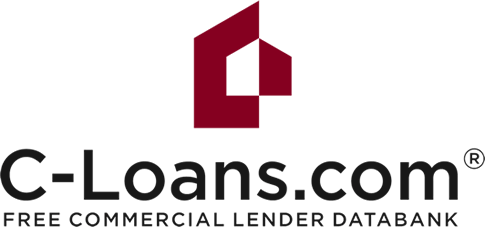Apply in just four minutes
Your Commercial Loan Portal to 750 Commercial Lenders
This commercial mortgage portal allows you to apply to 750 commercial lenders in just four minutes. You simply input your loan request. The C-Loans® System will then screen out all of the unsuitable lenders and provide you with a list of 30 (or so) banks which are perfect for your particular request. You can then call these banks, life companies, conduits, REIT’s or hard money lenders directly or submit your request electronically, six lenders at a time. And C-Loans® is FREE!
Get to Know C-Loans
Commercial Mortgage Loans by C-Loans
Our Popular Services & Products
FREE SBA Loans
C-Loans.com will give you 200 SBA loan leads for free and perfect for your bank. These SBA loan leads will be the ideal size for your bank.
Banks and Direct Lenders
If you need more commercial loans, please find more information here. *Servicing $20 million+ in commercial loans.
Commercial Mortgage Broker Training
You will learn over 65 tips on improving your commercial loan business.



Get to Know About
Cool Stuff for Borrowers and Brokers
People just like you have closed over 1,000 commercial real estate loans, totaling over $1 billion, using C-Loans. Our software identifies which bankers are hungry and which ones are “sleepy.” Then it directs your loan to the perfect banker, life company lender, CMBS lender, or private money lender for your particular deal. Remember, every commercial loan is different, and every commercial lender has its own niche.
Borrowers and Brokers
Commercial Mortgage Tools from C-Loans

Success Stories
C-Loans Testimonials
I want to first personally thank you. I “trained” with Cushman & Wakefield for 2 years, and yet 90% of the knowledge I use is from you.
Stuart Faass

You didn’t know it but I watched your videos at least 10 times and you were my mentor back then. I still use your broker agreement.
Ron

I bought your video course back in 2005 when I first got into the commercial end of the mortgage business. You have been invaluable in my success.
Ronald

I am very impressed by C-Loans. You have accumulated a great group of financing options and lenders who are responsive and very helpful to explain their sweet spots.
Melanie

Just wanted to say how overwhelmed we have been with quality responses from lenders. We are so glad we ran across C-Loans on the Internet.
Larry

I am currently going through your training videos on finding hard money investors … I would just like to say that I find this to be very valuable.
Nathan Goodman

I submitted a loan scenario to your lender network, and I have been very pleased with the speed and response of your lenders. Congratulations!
Juan

Get Expert Advice from George Blackburne
Primer on Commercial Loan Finance
Please forgive me if this first section sounds like a sales pitch; but I have an important concept to convey. Even if you are an old pro at commercial real estate finance, you will find our free commercial mortgage portal, C-Loans.com, to be a great way to quickly present your commercial loan request to hundreds of different banks.
Here’s that important concept:
Why present your loan to so many banks? There is a bank out there right now that is too flush with cash. The bank president is yelling at his senior vice president, “We need to make some commercial loans right now!” It is this too-liquid bank which will give you the largest new loan at the lowest interest rate. The C-Loans System (we spent $2.2MM writing this code) helps you to pinpoint that too-liquid bank.
Are you looking for an SBA loan to buy a building for your business? Grasp this concept: Every SBA lender is different.
Your application for an $600,000 SBA loan to buy a campground could get turned down by 19 banks, only to have the 20th bank approve your deal because the president of that particular bank happens to own a $300,000 RV and loves to camp. There are over 250 different SBA lenders on C-Loans, and in just four minutes you can submit your deal to all of them, six lenders at a time.
Are you looking for a loan to buy an investment property, like an apartment building, office building, and or retail center? Once again – The hungriest bank will give you the most leverage and require the smallest down payment.
Who is the hungriest bank? Among our 750 different banks, this changes daily, depending on which bank just got some loan payoff’s or some huge new deposits. Submitting your commercial loan using C-Loans helps you to instantly identify which SVP of Real Estate Loans is getting chewed out by his boss. Haha!
Does your deal have some black hairs? Maybe your company is losing money. Maybe you went through a divorce and went bankrupt two years ago? There are over 300 commercial lenders – subprime lenders and hard money lenders – on our portal who specialize in making less-than-perfect commercial loans. As you fill out your mini-app, you’ll see a section named, “Special Issues”. Just identify your concern. For example, “One of my two retail spaces is vacant; but unfortunately I have a balloon payment coming due, so I have to borrow right now.” Boom. The lenders will screen themselves, and the forgiving ones will reach out to you with offers.
The word “commercial” is just a fancy word for “business”, so a commercial loan is just another way of saying business loan. To really understand what constitutes a commercial real estate loan, it is easier to understand what it is not.
A loan secured by a single-family residence, a condo, a townhouse, a duplex, a triplex, or a 4-plex is considered to be a residential loan. In the parlance of the industry, such properties are known as one-to-four family dwellings, and loans secured by 1-4 family dwellings are considered to be residential loans.
Residential loans are special because they can be sold overnight to Fannie Mae or Freddie Mac in a pinch. Because they are liquid investments, loans secured by one-to-four family dwellings enjoy MUCH lower interest rates – as much as 1.25% lower.
Definition of a Commercial Loan: A commercial real estate loan is therefore a real estate loan that is NOT secured by a one-to-four family dwelling. A land loan is an example of a commercial real estate loan. Surprised?
Example:
You own a four-plex, and all of the units are rented out to tenants. You are holding the property as an investment to provide income for your retirement. You want to refinance your four-plex to pull out some equity in order to buy a five-plex. The loan against your non-owner-occupied four-plex is a commercial loan because it is an investment property, and the purpose of the loan is not for personal, family, or household purposes. True or false?
False! A loan on your existing four-plex is still a residential loan, even though the property is non-owner-occupied. As a residential loan, it will enjoy an interest rate that is at least three-quarters of a percent lower than the commercial loan that you will eventually get on your new five-plex.
Remember, the cutoff is four units. If the multifamily property has more than four units, you need to apply to a commercial lender. To get a residential loan on your non-owner-occupied 4-plex, you should apply to a residential lender, like Quicken Loans. To get a commercial loan on your new 5-plex, you should apply using C-Loans.
There are more than a dozen different types of commercial loans, although most real estate investors will only use one of the first five types:
Permanent Loans – This is the most common type of commercial real estate loan. A permanent loan is a garden-variety first mortgage on a commercial property. To qualify as a permanent loan, the loan must have a term of at least five years and some amortization. In other words, a permanent loan cannot just have interest-only payments. In contrast with residential loans, which often enjoy a 30-year amortization, most commercial permanent loans have a 25-year amortization. If the property is older than 35-years-old, the lender might even a 20-year amortization. The one exception to this rule is multifamily properties (apartment buildings). Most multifamily permanent loans have a 30-year amortization. Most commercial permanent loans are made by banks, and, with the exception of multifamily properties, have a maximum term of ten years.
SBA Loans – If your business partially-occupies a commercial property, this is the loan for you. SBA loans are NOT made by the Small Business Administration (“SBA”). The SBA merely guarantees certain commercial loans made by banks and specialty finance companies. If you have been in business for at least three years, you can get an SBA loan of 90% loan-to-value to buy a building for your business to occupy; otherwise, you’ll have to put 30% down. The SBA only guarantees a portion of an SBA loan, so the bank making the loan has some of its own dough at risk. This is why 19 SBA lenders could turn your deal down, only to have the 20th SBA lender approve your deal. There are over 250 different SBA lenders on C-Loans.
Construction Loans – These loans are used to pay for the construction of commercial buildings, residential subdivisions (tracts of houses), and residential condominium developments. Construction loans usually have a term of just one year, although a six-month extension can sometimes be negotiated for an extra point. The bank doesn’t just give the borrower $3 million and hopes he builds the apartment building, as opposed to skipping to Mexico. Instead, the bank only advances funds as work is completed. For example, when the grading is done, the grading contractor is paid. The interesting thing about construction loans is that while they have interest-only monthly payments, a reserve, funded by the bank, is created at the beginning of the loan to make these monthly interest payments. The borrower only has to pay interest on the amount of the construction loan that has been drawn down to date. In other words, the interest payment in month one is usually very small because the developer has used very little of the loan proceeds. Construction loans are made by local lenders, rather than by some big bank in faraway New York City, because someone from the bank has to go out to the property regularly to inspect the progress of construction before it approves any disbursements to the subcontractors. These visits are called progress inspections, and there is small fee to the borrower for each one.
Bridge Loans – A bridge loan is a short-term loan, and most bridge lenders can fund these loans very quickly (30 days versus the normal 75 days). Bridge loans have a term of between one year and five years, and they have interest-only monthly payments. Bridge loans are usually much more expensive than permanent loans or construction loans. Bridge loans are often used on valued-added projects, where the finished value of the project is projected to be much higher than the cost to acquire the property and to renovate it. They can also be used to give the owner time to find a tenant. Large bridge loans ($3 million+) are usually floating rate loans, tied to LIBOR. (Did you know that LIBOR will stop being computed on January 1, 2022 because of all of the corruption associated with its computation?) Another type of bridge loan is a short-term loan made by a hard money lender. Hard money bridge loans can be for any purpose, not just to renovate the property. Hard money bridge loans usually have a fixed rate. There are 300+ bridge lenders on C-Loans.
USDA Business &Industry Loans – You may have never heard of the USDA Business and Industry (“B&I”) loan program, but it is very similar to the SBA loan program. Some of the poorest Americans live in rural areas, where there are few job opportunities. The purpose of B&I loans is to bring jobs to rural areas, defined as cities of less than 50,000 in population. Unlike SBA loans, B&I loans do NOT require that the property be owner-used, as long as the loan is projected to bring jobs to the rural area. USDA B&I loans can be as large as $25 million, compared to just $10 million for an SBA loan. They can have fixed rates and have a 30-year amortization. That portion of the loan secured by equipment can have a term as long as fifteen years, compared to just ten years on SBA loans. There are 125+ USDA commercial lenders on C-Loans.
There are a whole bunch of other types of commercial loans, but most of them don’t apply to the typical commercial real estate investor. We will discuss them much further below in the section, “Other Types of Commercial Mortgages”.
Let’s talk first about the interest rate on commercial permanent loans (garden-variety first mortgages). Earlier we mentioned that commercial mortgage rates are typically 75 to 125 basis points higher than residential mortgage rates. A basis point is 1/100th of one percent, so 125 basis points is 1.25%. Therefore, if the 30-year conforming mortgage rate is 4.0% today, then commercial mortgage rates would be around 4.75% to 5.25%.
Here is something that will surprise you. Banks from Maine to Florida, to California, and to Hawaii generally have almost the exact same conventional commercial mortgage rates, terms, and programs. There is almost no price competition in banking. Banks move together like a giant herd. Moooo.
The typical commercial permanent loan from a bank has a fixed rate for the first five years. Then there is one rate-readjustment to market. The interest rate is then fixed for five more years. The loan is amortized over 25 years, and it has a term of ten years. There is generally some sort of declining prepayment penalty, like 3-2-1 or 5-4-3-2-1. There will be a six-month window at the end of five years, and then the prepayment penalty will apply again to the second five years. And remember, most banks have this exact same program.
So what is the interest rate? You can predict it with some precision. Just look up five-year Treasuries on the internet and then add between 275 to 350 basis points (2.75% to 3.5%). Therefore, if five-year Treasuries are 2.0% today, your rate will be between 4.75% to 5.5%. Obviously, only the very best deals get the lowest rate.
What about SBA loans? Most SBA loans are made using the 7a Program, which is a 25-year, fully-amortized, floating-rate loan. The rate is tied to prime, with a margin of 1.5% to 2.75%. Almost all SBA loans are closed at 2.75% over prime. Your deal would have to be pretty awesome to qualify for a margin of only 1.5%.
Commercial construction loans are typically priced at prime + 1% to 1.5% floating, 1 to 1.5 points, one year, interest-only.
Bridge loans vary greatly in price, depending on the quality of the deal and the borrower. High-net-worth borrowers, on large, good-quality properties can get floating-rate bridge loans tied to LIBOR, with a margin as low as 4.5% to 5.5%. (LIBOR is really-really low.) Average deals to clean borrowers might be priced at 6% to 8% floating over LIBOR. The points would be 1.5 to 2.5.
Hard money bridge loans are typically fixed rate loans with rates as low as 8% (in California), 9% to 10% nationwide, and sometimes as high as 12% to 13% on riskier deals. The points are typically 2 to 3.
Few people know about the USDA commercial loan program, but the program is terrific. If the deal is really good, you can negotiate a fixed rate and a 30-year amortization; otherwise, the rates and terms on a USDA Business and Industry loan are similar to those of SBA loans.
SimpleTransparentSecure



